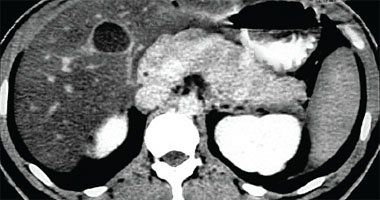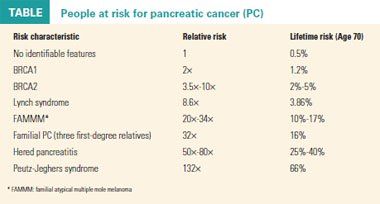The Optimal Rx for Pancreatic Cancer: Stop It Before It Starts
Screening is the key to protecting those at risk for pancreatic cancer, according to presenters at the 2010 Gastrointestinal Cancers Symposium.
ABSTRACT: Screening is the key to protecting those at risk for pancreatic cancer, according to presenters at the 2010 Gastrointestinal Cancers Symposium.

CT scan of the abdomen, axial section, showing pancreatic cancer. This scan was taken after an iodine injection and barium opacifi cation of the stomach.
ORLANDO-Identification of the diagnostic and treatment milestones that have turned some cancers into manageable chronic diseases has eluded researchers of pancreatic cancer. Diagnosis generally happens at a later stage and the survival rate is dismal even among patients for whom treatment is successful. Pancreatic cancer experts are calling for a solution that has proven to be a boon, and sometimes a bane, for other cancers: screening.
"For surgical margin-negative, lymph node-negative patients, survival is still only 30% at best. Therefore, we need to think about screening individuals at highest risk to identify high-grade precursor lesions and to intervene prior to progression. Ultimately, of course, we need to prove this saves lives," said Marcia I. Canto, MD, MHS, an associate professor of medicine and oncology at Johns Hopkins University in Baltimore.
Dr. Canto and Samir Hanash, MD, from Seattle's Fred Hutchinson Cancer Research Center, offered their insights into imaging and biomarkers that are paving the way for the possibility of widespread pancreatic cancer screening.
The Johns Hopkins experience
Pancreatic precursor lesions include intraductal papillary mucinous neoplasm (IPMN), pancreatic intraepithelial neoplasia (PanIN), and microinvasive adenocarcinoma. Screening would be targeted to an identified high-risk population (see Table).

For familial pancreatic cancer, screening should begin at an age that is 10 years younger than the youngest affected relative; for the very high risk syndromes it should begin at age 30. Surveillance intervals would depend on the baseline result, but should be every one to two years for those with normal baseline findings, Dr. Canto said.
Screening modalities at Johns Hopkins include endoscopic ultrasound (EUS) and, increasingly, MR cholangiopancreatographic imaging (MRCP), with endoscopic retrograde cholangiopancreatography (ERCP) reserved for select cases. Patients with neoplastic lesions undergo resection, with follow-up assessment by EUS at three to six months, and by EUS plus MRI at one year. Patients with negative findings undergo EUS and MRCP evaluation one year later as well.
Screening seeks to reveal pancreatic masses, including adenocarcinoma and endocrine tumors, and pancreatic cysts. Multifocal branch IPMN has frequently been identified on MRCP. EUS evaluates for pancreatic duct dilation or focal narrowing, focal polypoid pancreatic duct wall thickening, pancreatic duct echogenic material, and features of chronic pancreatitis. ERCP evaluates the ampulla (gaping, mucus), and looks for dilation, stricture, and filling defects in the pancreatic ducts, Dr. Canto said.
Published reports from screening programs for high-risk patients show diagnostic yields of 4% to 23%. At Johns Hopkins, screening of individuals with at least three first-degree relatives diagnosed with pancreatic cancer and of those with Peutz-Jeghers syndrome found lesions in 5.3% using EUS and 10.2% using EUS plus CT. Of the 302 individuals in these programs, screening identified six cancers (five subjects are still alive), 20 cases of single or multiple IPMNs, and three cases of pancreatic endocrine neoplasia.
"At Johns Hopkins University, over 380 patients have been screened to date in our very selective screening program, and 24 underwent 30 operations," Dr. Canto noted. "Many had PanIN multifocality and 26% had high-grade neoplasia. All patients are alive and undergoing surveillance."

She noted that screening and surveillance of high-risk patients has a diagnostic yield that averages 10% for prevalent neoplasms and 96% for moderate-grade or high-grade dysplasia. In the Hopkins series, surgical resection has proven to be safe, with no deaths or severe morbidity among patients undergoing partial resection, partial followed by completion resection, or total pancreatectomy.
"We believe you can argue for this approach in some individuals," Dr. Canto said.
Closing in on biomarkers
Recent genomic, transcriptomic, and proteomic studies have provided leads for molecular diagnostics in pancreatic cancer. Dr. Hanash, head of molecular diagnostics at Fred Hutchinson, described the ideal molecular diagnostic exam: A blood-based test that would measure the novel circulating proteins associated with cancer development and their related signaling pathways. Also, the test should involve the novel tumor antigens that induce an immune response such as autoantibodies that indicate an early-stage neoplasm, he explained.
For identifying high-risk patients, the insulin growth factor (IGF) pathway has already been singled out. Low levels of IGFBP-1 are associated with a twofold to fourfold increased cancer risk, although levels of IGF-1, IGF-2, and IGFBP-3 have not been linked to the same increase in risk, he said.
"For establishing risk, we are still relying on patient characteristics, including age, smoking [history], diabetes, chronic pancreatitis, and family history. There is suggestive evidence that obesity, diet, and alcohol may have a minor role," Dr. Hanash said. With biomarkers, the emphasis is more on very early detection. This is a daunting proposition because the characteristics of the marker must be outstanding, given the low overall incidence of pancreatic cancer, Dr. Hanash pointed out.
Such biomarkers would be applied to persons deemed at risk for the tumor, but there are issues with that, as well. "Some preneoplastic lesions never progress to cancer. It is helpful to detect them, but you must be cautious in intervening unnecessarily. It is a challenge," he said.

The circulating protein CA 19-9 is now being used to monitor disease; rising levels of CA 19-9 after resection are a sign of relapse, and high levels correlate with unresectable tumors. But CA 19-9 tests suffer from low specificity because high levels of the circulating protein are seen in chronic pancreatitis as well as cancer. So by itself, CA 19-9 is not reliable for screening, Dr. Hanash said.
However, several other proteins appear promising as biomarkers, including Muc1, which can discriminate between newly diagnosed cancer and case controls, and cytokeratin 18, which is associated with advancedstage disease. Combinations of proteins, or panels, will probably be the most useful, he predicted.
Aside from proteins, nucleic acids in the blood are interesting candidates as screening tools. MicroRNAs, especially miR-155, have potential in early detection efforts. In a recent study, a panel of four mRNAs (including miR-155 and others) demonstrated 64% sensitivity and 89% specificity in discriminating cancer cases from controls (Cancer Prev Res 2:807-813, 2009).
But how mRNAs will perform in early-stage disease has not been determined, Dr. Hanash said. "We want to find neoplastic lesions before they are invasive, so there are problems with profiling patients at the time of diagnosis and predicting how candidate markers will perform for early detection," he said.
The GI Cancers Symposium was sponsored by ASCO, ASTRO, the American Gastroenterological Association, and the Society of Surgical Oncology.
Gene profiles that are unique to cancer (not shared with chronic pancreatitis) are also making headway as biomarkers. The overexpression of S100P has been associated with pancreatic cancer and the IPMN precursor lesion, but not normal tissue. But the ability to identify this in the blood has not been realized. KRAS mutations can be detected in the blood but the mutations are also seen in pancreatitis.
The field is advancing largely due to the availability of an engineered mouse model that closely mimics human pancreatic cancer. Mouse models also offer the potential for sampling at different stages of tumor development, which can reveal unique proteomic changes. Investigators have, in fact, developed a panel of such proteins that has been validated in humans, showing the power to discriminate between persons who will develop pancreatic cancer within one year and those who will not, Dr. Hanash said. "We are now in the middle of producing assays for the most promising candidates, and we hope to come up with a set of novel markers that will have relevance for early detection."
Sonic hedgehog inhibitors on target to change drug delivery
The signaling pathway may have a name that any computer gamer would love, but the sonic hedgehog has the potential to be a great therapeutic target for ligand-dependent and ligand-independent cancers, said David Tuveson, MD, PhD, of Cambridge University and Addenbrooke's Hospital in the UK.
Activation of the hedgehog pathway by its ligand sonic has been implicated in pancreatic tumorigenesis. Sonic hedgehog (SHH) contributes to the extensive stromal reaction in pancreatic tumors, to the maintenance of cancer stem cells, and possibly to marked desmoplasia in tumors and to chemoresistance.
The value of targeting the hedgehog pathway has been demonstrated in the mouse model. "For precancerous lesions you cannot tell the mouse from the human because the model has all the same molecular, cellular, and pathologic hallmarks of human cancer," Dr. Tuveson said.
Drug resistance in pancreatic ductal adenocarcinoma seems to involve poor drug penetration as the primary problem. "Methods that modify the stroma and alter tumor perfusion are needed," he said. "Inhibitors of the hedgehog pathway are one way to accomplish this."
The experimental SHH inhibitor IPI-926 can penetrate tumors and achieve therapeutic levels, inducing a 10-fold reduction in transcription factor and clearly affecting the molecular target. Pretreatment of a tumor with IPI-926 enhances the concentration of gemcitabine (Gemzar) in the tumor by 50%, and this translates into a measurable extension of survival in the mouse model. Mice treated with gemcitabine alone lived an average of 45 days compared with 80-plus days with the combination, Dr. Tuveson reported at the GI Cancers Symposium.
Improved survival
Robert McWilliams, MD, of the Mayo Clinic in Rochester, Minn., reported the results of a study of 605 patients with pancreatic cancer (all stages) evaluated for an association between SHH single nucleotide polymorphisms (SNPs) and survival. Carrying minor alleles in an SNP in the SHH gene rs1233556 was associated with a 16% increased survival overall (P = .033) and a 28% increase in survival among patients with metastatic disease (P = .02). The variant was also associated with the magnitude of SHH expression and the degree of desmoplasia in primary tumors (abstract 126).
"This is further evidence that the hedgehog pathway is important in pancreatic cancer and provides a paradigm for developing new sonic hedgehog pathway-based prognostic and therapeutic tools," Dr. McWilliams said. Based on the current study, it is also possible that certain genotypes may help patients who have them derive the most benefit from SHH inhibitors, he added.